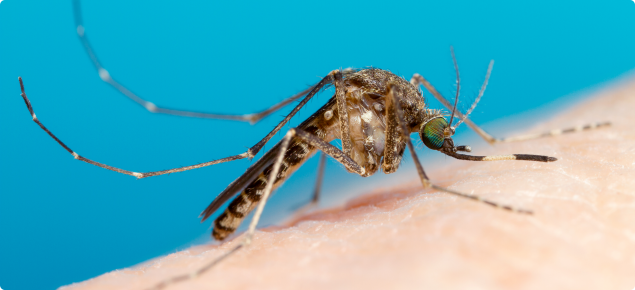About Japanese encephalitis
JE is a reportable, acute mosquito-borne viral disease that can cause reproductive losses and encephalitis in susceptible species. The disease occurs mostly in pigs and horses but can also rarely cause disease in people who are bitten by infected mosquitoes.
JE is not a food safety concern. Commercially produced pork meat or pork products are safe to consume.
For more information about the risk of JE to human health and human vaccination options, please refer to the Department of Health website.
Animals most commonly become infected through the bite of infected mosquitoes, though vector free transmission of the virus by direct contact, semen and embryos has been reported in pigs. The normal lifecycle of JE cycles between waterbirds, pigs and mosquitoes, which may then spill over to horses and humans.
The most common clinical signs of JE in pigs are reproductive losses including abortions, mummified foetuses and stillborn or weak piglets. Tremors and convulsions are occasionally seen in pigs up to six months of age.
In horses, most clinical disease is mild and may be unrecognised, however fever, decreased or no appetite, lethargy, wobbliness and incoordination may occur. Some horses may die.
Pig and horse owners should be highly vigilant for signs of this disease. If you suspect any animal is showing signs of the disease, you must report it. You can do this by contacting your local veterinarian, your local DPIRD Veterinary Officer or the national Emergency Animal Disease Watch Hotline on 1800 675 888. Contacting the hotline will put you in touch with a DPIRD veterinarian.
Pig and horse owners should also manage mosquitoes on their property to minimise potential human and animal exposure to mosquito-borne viruses. This involves emptying, covering or discarding any water holding containers. Permanent effluent ponds or water bodies should be well maintained to prevent mosquito breeding. Speak to your local government environmental health officer for advice if mosquito numbers remain problematic.
For advice on control mosquitoes in pggeries, please refer to the Mosquito Management in Piggeries guidelines.
Good biosecurity practices and restricting contact between pigs and wild birds is also essential.
Response to JE detections 2022
The Australian and State and Territory Government Departments of Health and Departments of Agriculture, are working closely together to protect public and animal health.
National working groups of animal biosecurity, communicable disease, human vaccine and arbovirus experts have been established to support the response. Their work includes planning and implementing mosquito surveillance and control measures as well as identifying animal and human populations at risk, and for the rollout of human vaccines.
DPIRD is undertaking surveillance activities to assist with understanding the distribution of JE in Australia.
To reduce the likelihood of JE being introduced to WA through movements of pigs and semen, live pig imports have been suspended and movement controls are in place for semen. For updated information and applications on livestock and commodity movement, please see the DPIRD importing livestock page:
It is not known how the virus came into mainland Australia. The movement of infected mosquitoes or migratory waterbirds may have played a part in the virus’ spread.
Australia has national plans in place to respond to animal disease incursions. The AUSVETPLAN Response Strategy – Japanese encephalitis outlines the response approach to this disease.
Clinical signs in animals
Although clinical signs of the disease are rare in species other than pigs and horses, it has been detected in a wide range of species including cattle, sheep, goats, chickens, ducks, dogs, cats, flying foxes, bats, frogs, snakes and lizards.
Pigs
The most common clinical signs in pigs are stillborn or weak piglets, or neonates with neurological signs. Litters from sows and gilts would be expected to be equally affected when the disease is first introduced.
Piglets under six months of age infected after birth can develop encephalitis where signs such as paddling, tremors or convulsions may be seen. Wasting, depression or hindlimb paralysis may be seen in suckling and weaner piglets. Adult sows do not typically show obvious signs of disease. Boars may experience infertility and oedematous, congested (enlarged) testicles
Horses
Horses and other livestock are considered dead-end hosts and do not develop viraemia substantial enough to infect mosquito vectors. They therefore do not play a role in transmission to other animals or people.
Many infected horses will show no clinical signs while others may show mild clinical signs such as fever, anorexia, lethargy, and jaundice that generally last for 2-3 days. In more severe cases encephalitis can also occur. Encephalitis can present as incoordination, difficulty swallowing, impaired vision, and rarely a hyperexcitable form can occur. Some horses with encephalitis recover but for others the disease is fatal. JE has also been reported in donkeys.
Risk to human health
For human health information visit the Healthy WA website.
JE is not a human food safety concern.
What to do if you suspect JE in your animals
Japanese encephalitis is a reportable disease. If you suspect JE in any animal immediately contact your local DPIRD Veterinary Officer or phone the Emergency Animal Disease Watch Hotline (1800 675 888).
Subsidised disease testing and investigation is available in cases that are consistent with JE. For information about subsidised disease testing, contact your local veterinarian or see the Significant Disease Investigation Program webpage.
For more information about how to increase biosecurity practices in your piggery, please refer to the Pork Biosecurity Manual.

